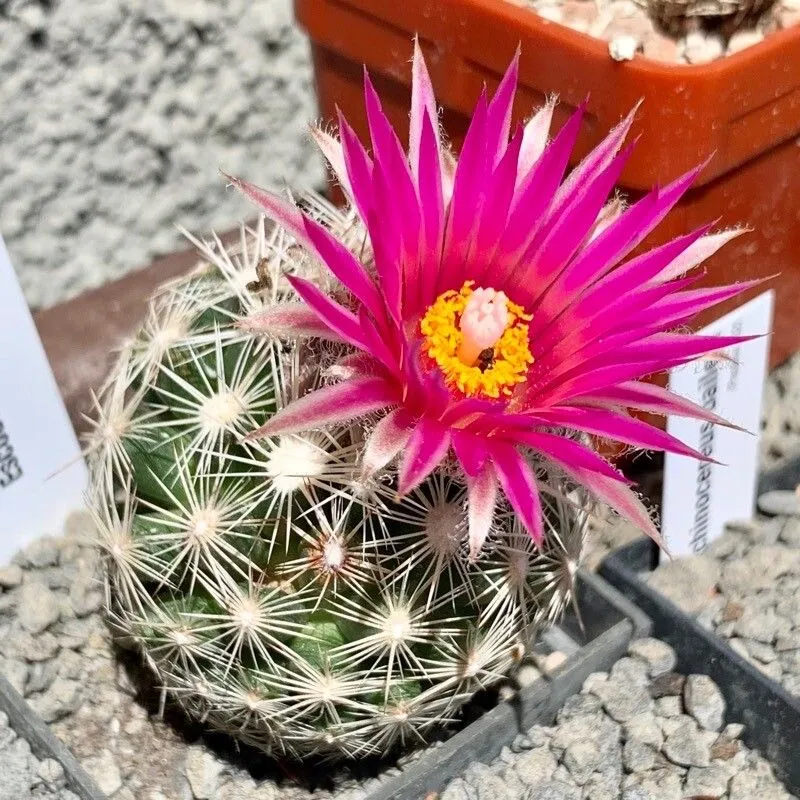

Family: Cactaceae
Author: (Nutt.) Buxb.
Bibliography: Oesterr. Bot. Z. 98: 78 (1951)
Year: 1951
Status: accepted
Rank: species
Genus: Escobaria
Vegetable: False
Observations: S. Canada to N. Mexico
Description
The Beehive cactus, scientifically known as Escobaria vivipara, is a remarkable and resilient member of the Cactaceae family. This fascinating plant was documented in the scientific literature “Oesterr. Bot. Z.” in 1951 by the author Buxbaum, further consolidating its botanical importance.
Native to a wide geographical range, the Beehive cactus is found from southern Canada to northern Mexico. This broad distribution emphasizes its adaptability to various climatic and environmental conditions. The cactus thrives in dry, rocky terrains, often in well-drained soil which accommodates its need for minimal water intake.
The Beehive cactus stands out due to its distinctive appearance. It typically forms small, rounded clusters, resembling a beehive—hence its common name. The plant’s stem is densely covered with tubercles, each armed with a cluster of sharp spines that serve as a protective mechanism against herbivores. During the blooming season, Escobaria vivipara adorns itself with beautiful flowers, which range in color from pink to magenta, adding a splash of vibrant hues to its arid surroundings.
Well-adapted to harsh desert conditions, the Beehive cactus exhibits a variety of survival strategies. During extended dry periods, it can shrink and conserve water by drawing moisture from the air through its specialized skin. This adaptability not only ensures its survival in some of the most extreme habitats but also makes it an interesting subject of study for botanists and plant enthusiasts.
Given its broad range and resilient nature, the Beehive cactus is an excellent example of the incredible diversity and adaptability found within the Cactaceae family. Its unique characteristics and striking beauty make it a noteworthy species, deserving of attention both in natural habitats and cultivation efforts aimed at preserving its legacy.
Common Names
En: Beehive cactus, Pincushion cactus, Spinystar, Spinystar cactus, Alverson’s Pincushion Cactus, Ball Pricky-pear Cactus, Bisbee Pincushion Cactus, Viparous Foxtail Cactus, Pink pincushion cactus, Purple ball cactus
Ar: إسكوبارية ولودة
Fr: Mamillaire vivipare
Sv: Tuvescobaria
Synonyms
- Coryphantha neovivipara var. neomexicana ((Engelm.) Y.Itô)
- Escobaria vivipara var. rosea ((Clokey) D.R.Hunt)
- Mammillaria vivipara var. arizonica ((Engelm.) L.D.Benson)
- Escobaria vivipara var. neomexicana ((Engelm.) Buxb.)
- Mammillaria vivipara var. aggregata ((Britton & Rose) L.D.Benson)
- Mammillaria vivipara var. deserti ((Engelm.) L.D.Benson)
- Coryphantha vivipara var. neomexicana ((Engelm.) Backeb.)
- Mammillaria radiosa var. deserti ((Engelm.) K.Schum.)
- Mammillaria vivipara subsp. radiosa ((Engelm.) Engelm.)
- Coryphantha vivipara var. deserti ((Engelm.) W.T.Marshall)
- Mammillaria radiosa (Engelm.)
- Mammillaria vivipara var. vera (Engelm.)
- Coryphantha vivipara var. bisbeeana ((Orcutt) L.D.Benson)
- Coryphantha neovivipara var. aggregata ((Britton & Rose) Y.Itô)
- Escobaria oklahomensis ((Lahman) Buxb.)
- Coryphantha vivipara ((Nutt.) Britton & Rose)
- Escobaria aggregata ((Britton & Rose) Buxb.)
- Mammillaria radiosa var. vivipara ((Nutt.) Schelle)
- Coryphantha bisbeeana (Orcutt)
- Mammillaria vivipara var. radiosa ((Engelm.) Engelm.)
- Mammillaria ramosissima (Quehl)
- Escobaria deserti ((Engelm.) Buxb.)
- Neomammillaria radiosa ((Engelm.) Rydb.)
- Cactus viviparus (Nutt.)
- Coryphantha neovivipara ((Viv.) Y.Itô)
- Escobaria vivipara var. bisbeeana ((Orcutt) D.R.Hunt)
- Mammillaria deserti (Engelm.)
- Echinocactus viviparus ((Nutt.) Poselg.)
- Coryphantha vivipara var. rosea ((Clokey) L.D.Benson)
- Cactus radiosus (J.M.Coult.)
- Mammillaria radiosa f. arizonica ((Engelm.) Schelle)
- Mammillaria radiosa var. arizonica ((Engelm.) K.Schum.)
- Mammillaria radiosa f. deserti ((Engelm.) Schelle)
- Cactus radiosus var. arizonicus ((Engelm.) J.M.Coult.)
- Escobaria vivipara var. kaibabensis ((P.C.Fisch.) N.P.Taylor)
- Coryphantha columnaris (Lahman)
- Coryphantha alversonii ((J.M.Coult.) Orcutt)
- Mammillaria arizonica (Engelm.)
- Escobaria arizonica ((Engelm.) Buxb.)
- Cactus radiosus var. deserti ((Engelm.) J.M.Coult.)
- Escobaria neomexicana ((Engelm.) Buxb.)
- Coryphantha neovivipara var. radiosa ((Engelm.) Y.Itô)
- Escobaria vivipara var. radiosa ((Engelm.) D.R.Hunt)
- Escobaria vivipara var. deserti ((Engelm.) D.R.Hunt)
- Neobesseya arizonica (Hester)
- Coryphantha vivipara var. radiosa ((Engelm.) Backeb.)
- Coryphantha radiosa ((Engelm.) Rydb.)
- Coryphantha vivipara var. kaibabensis (P.C.Fisch.)
- Coryphantha vivipara var. buoflama (P.C.Fisch.)
- Mammillaria vivipara subvar. neomexicana (Engelm.)
- Coryphantha vivipara var. arizonica ((Engelm.) W.T.Marshall)
- Cactus radiosus var. neomexicanus ((Engelm.) J.M.Coult.)
- Coryphantha vivipara var. aggregata ((Britton & Rose) W.T.Marshall)
- Coryphantha neovivipara var. arizonica ((Engelm.) Y.Itô)
- Coryphantha aggregata (Britton & Rose)
- Coryphantha chlorantha var. deserti ((Engelm.) Backeb.)
- Coryphantha deserti ((Engelm.) Britton & Rose)
- Cactus neomexicanus ((Engelm.) Small)
- Mammillaria radiosa var. texensis (Schelle)
- Mammillaria hirschtiana (F.Haage)
- Coryphantha rosea (Clokey)
- Coryphantha fragrans (Hester)
- Coryphantha oklahomensis (Lahman)
- Escobaria vivipara var. arizonica ((Engelm.) D.R.Hunt)
- Mammillaria neomexicana ((Engelm.) A.Nelson)
- Coryphantha vivipara f. sonorensis (P.C.Fisch.)
- Escobaria vivipara var. buoflama ((P.C.Fisch.) N.P.Taylor)
- Coryphantha arizonica ((Engelm.) Britton & Rose)
- Mammillaria vivipara ((Nutt.) Haw.)
- Escobaria bisbeeana ((Orcutt) Borg)
- Coryphantha alversonii var. exaltissima (E.F.Wiegand & Backeb.)
- Echinocactus radiosus (Poselg.)
- Coryphantha neomexicana ((Engelm.) Britton & Rose)
Distribution
- Alberta (native)
- Arizona (native)
- California (native)
- Colorado (native)
- Kansas (native)
- Manitoba (native)
- Mexico Northeast (native)
- Mexico Northwest (native)
- Minnesota (native)
- Montana (native)
- Nebraska (native)
- Nevada (native)
- New Mexico (native)
- North Dakota (native)
- Oklahoma (native)
- Saskatchewan (native)
- South Dakota (native)
- Texas (native)
- Utah (native)
- Wyoming (native)
Additional Images
Flower


Taken Jun 18, 2022 by Smallbeech (cc-by-sa)
Leaf


Taken Aug 28, 2021 by Smallbeech (cc-by-sa)


© copyright of the Board of Trustees of the Royal Botanic Gardens, Kew.
Sources
- POWO (http://powo.science.kew.org/taxon/urn:lsid:ipni.org:names:97526-2)
- PlantNet (https://identify.plantnet.org/species/the-plant-list/Escobaria vivipara (Nutt.) Buxb.)
- GBIF (https://www.gbif.org/species/3084514)
Specifications
Growth habit>: Shrub
Growth
